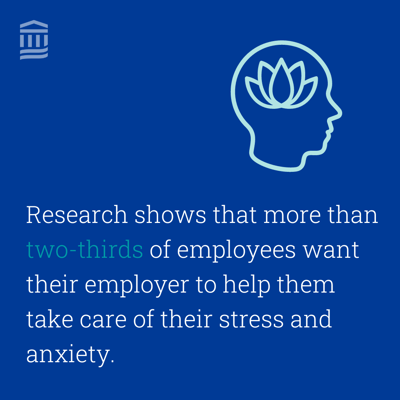The big benefits of meeting your employees' behavioral health needs
A 2023 study on workplace mental health found that more than two-thirds of employees want their employer to help them take care of their stress and anxiety. The research also noted that employers have an incentive to do so, as mental health can impact employee performance and potentially increase costs to employers, such as health insurance costs. “The study highlights the urgency employers should feel to implement an effective mental health strategy into their workplace,” says Scott Domann, chief people officer at Calm.
According to the American Medical Association (AMA), the term “behavioral health” refers to mental health, substance use disorders, life stressors, and stress-related physical symptoms. The AMA notes that about one in five adults in the U.S. has a clinically significant mental health or substance use disorder, and that’s likely to continue since the prevalence and severity of these issues have risen sharply among teenagers. Despite having health insurance, many employees still aren’t getting help:
- 40 percent with severe or chronic depression or anxiety didn’t get care in 2022
- 28 percent with complex mental health needs such as bipolar disorder, PTSD, or ADHD didn’t get care in 2022
Employees’ mental health has an impact on employers
Behavioral health difficulties don’t just affect individuals and families—they can also have a ripple effect on employers, leading to challenges with lower productivity and higher healthcare costs. Here are some key examples:  Mental health affects physical health: The Centers for Disease Control and Prevention (CDC) notes that mental health disorders are among the most burdensome health concerns in the U.S., because many people with these disorders also need care for other physical health conditions such as heart disease, respiratory illness, and disorders that affect muscles, bones, and joints.
Mental health affects physical health: The Centers for Disease Control and Prevention (CDC) notes that mental health disorders are among the most burdensome health concerns in the U.S., because many people with these disorders also need care for other physical health conditions such as heart disease, respiratory illness, and disorders that affect muscles, bones, and joints.
Costs for treating people with both mental health disorders and other physical conditions are two to three times higher than for those without co-occurring illnesses. In some cases, addressing behavioral health at an early stage can actually help prevent some physical ailments from developing.
Wellness programs can offer performance gains: The CDC reports that workplace wellness programs can identify those at risk and connect them to treatment; for example, these programs can help reduce and manage stress, which may mitigate some debilitating stress-related health problems such as migraines, lower back pain, and gastrointestinal disorders. Because mental and physical health are closely related, people with depression are two to four times more likely to increase employers’ medical spending compared to people without depression. As a result, for every $1 invested yearly in prevention and intervention programs to support mental health, employers can save $2 to $4 on other expenses.
With meaningful wellness resources in place, advantages for employers can include higher job performance, increased rates of engagement, better communication and stronger teams, improved physical capability, as well as higher morale. These programs can also be powerful for recruiting and retention as well since employees who feel more supported through wellness programs are less likely to switch jobs. .png?width=400&height=400&name=Sept%20Blog%20Social%20Content%20(1).png)
Employees feel there are gaps in support: According to a national employer survey done by consulting firm McKinsey, there’s often a disconnect between employers and employees when it comes to behavioral health needs. In the research, 71 percent of employers with frontline employees believe they’re supporting mental health very well, but only 27 percent of their employees agree that’s the case. When it comes to accessing care for substance use disorders, only 20 percent of employers believe that it should be a priority, even though 84 percent of employees responded that they wanted better access to this type of care.
Effect of presenteeism: When employees maximize sick days or take time off without warning for behavioral health issues, that can cause challenges throughout a company, but these issues can also lead to “presenteeism,” when employees are physically present but not engaged with work. For example, in one study of over 16,000 employees at a large financial services corporation, those with depression were more likely to struggle with time management and interpersonal communication, leading to lower productivity overall. Similarly, research looking at the effects of chronic conditions for more 6,000 employees across three different companies found that those with depressive symptoms were seven times more likely to report “decreased effectiveness” at work than other employees.
Smoking can have an impact, too: Substance use disorders include tobacco use, which can have a significant effect on employees even if they don’t smoke, vape, or chew while at work. The American Lung Association estimates that 35 percent of cigarette smokers have a behavioral health disorder and that nicotine dependency for those with behavioral health needs is two to three times higher than the general population.
Tobacco users already have higher healthcare costs—smoking accounts for nearly 12 percent of all U.S. annual personal healthcare expenditures—but if this is combined with other substance use such as alcohol, misused prescription drugs, or illicit drugs, those costs can climb even more.
All of this adds up to a greater need for identifying and addressing behavioral health needs in the workplace. When employers understand how these issues can impact their workforce, they can work with their health insurance provider to develop and employ effective strategies that offer resources and support.
If you’re a member of Mass General Brigham Health Plan, you can learn about our behavioral health offerings for mental health and substance use on our Behavioral Health Page.
